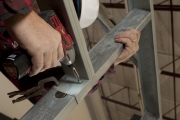Fixing a Leaky Toilet
Have a leaking toilet? Fixing it is easier thank you think. Watch our easy solution to a leaky toilet in Sixty Simple Seconds.
Finding water all over your bathroom floor from a leaky toilet is never a good situation. Fortunately, fixing the leak is only a few flushes away. One of the most common causes of a leaky toilet is the wax ring that sits between the toilet and the drain. Replacing a leaky wax ring is a quick DIY project that should be done when you first notice the leak. Watch this episode of 60 Simple Seconds for a quick look at how to replace a wax ring and fix that leaky toilet.








